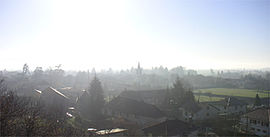Le Grand-Lemps
| Le Grand-Lemps | ||
|---|---|---|

A general view of Le Grand-Lemps
|
||
|
||
| Coordinates: 45°23′57″N 5°25′14″E / 45.3992°N 5.4206°ECoordinates: 45°23′57″N 5°25′14″E / 45.3992°N 5.4206°E | ||
| Country | France | |
| Region | Auvergne-Rhône-Alpes | |
| Department | Isère | |
| Arrondissement | La Tour-du-Pin | |
| Canton | Le Grand-Lemps | |
| Intercommunality | Bièvre Est | |
| Government | ||
| • Mayor (2014–2020) | Didier Rambaud | |
| Area1 | 12.9 km2 (5.0 sq mi) | |
| Population (2011)2 | 2,946 | |
| • Density | 230/km2 (590/sq mi) | |
| Time zone | CET (UTC+1) | |
| • Summer (DST) | CEST (UTC+2) | |
| INSEE/Postal code | 38182 /38690 | |
| Elevation | 434–724 m (1,424–2,375 ft) (avg. 480 m or 1,570 ft) |
|
|
1 French Land Register data, which excludes lakes, ponds, glaciers > 1 km² (0.386 sq mi or 247 acres) and river estuaries. 2Population without double counting: residents of multiple communes (e.g., students and military personnel) only counted once. |
||
1 French Land Register data, which excludes lakes, ponds, glaciers > 1 km² (0.386 sq mi or 247 acres) and river estuaries.
Le Grand-Lemps is a commune in the Isère department in southeastern France.
The area of the municipality is 1290 hectares (about 5 square miles). It is located at the edge of the plain of Bièvre (Beaver) river, halfway between Voiron and Saint-André-la-Côte.
The town is located on the axis between Rives, Isère and La Frette, Isère (RD73). The natural reserve of the pond Le Grand-Lemps is classified as européenne2 reserves. It is a natural area of ecological interest, flora and fauna which is (ZNIEFF) Type I/Zone No. 3800-7000.
The name "Le Grand-Lemps" was derived from the Latin 'Lampsacus', which was an ancient Greek city near the ancient city of Troy.
It is likely that the first tribes there, the Ligures, would have arrived and settled in the sixth century BC. Celtic Allobroges later came to mingle with the people. Around 120 BC began the Roman invasion of Gaul. A barbarian tribe the Burgundians later migrated to the area. In 486, Clovis I founded the kingdom of the Franks. After the victory in the Battle of Vézeronce in 524, the Franks claimed the region. In the later part of the sixth century there was the fragmentation of the land between the invaders and the beginning of feudalism. There was then a time of settlement of some Saracen hordes. This was followed by a less hectic period during the reign of Charlemagne, whose empire at his death in 843 was divided into three, leaving the geographic area under the domination of his grandson Lothair I.
...
Wikipedia



